engine Hyundai Getz 2002 Owner's Manual
[x] Cancel search | Manufacturer: HYUNDAI, Model Year: 2002, Model line: Getz, Model: Hyundai Getz 2002Pages: 428, PDF Size: 6.13 MB
Page 286 of 428

1- 42 FEATURES OF YOUR HYUNDAI
SB215B1-E ENGINE COOLANT TEMPERA- TURE GAUGE The engine coolant temperature gauge indicates the engine coolant tempera-ture and will, under normal circum- stances, give an indication in the "Nor- mal" or centre portion of the scale.Should the indication move into theupper or "Hot" portion of the scale,engine overheating is indicated. Underthese circumstances, the vehicle should be brought to rest as soon as is safe to do so and the engine turned off. Oncethe engine has cooled somewhat, thecoolant level and the condition of thegenerator/water pump drive belt shouldbe checked. If the cause of the over- SB215C1-E SPEEDOMETER
HTB007A
heating cannot be readily established, the assistance of a Hyundai dealershould be sought.
!
HTB004A
The speedometer indicates the vehicle speed in both miles and kilometres perhour.
WARNING:
The engine cooling system is pres-surized and removal of the radiator cap when the engine is hot may cause hot water and steam to beejected from the radiator resulting inburns and scalding. The radiator capmust only be removed when the en-gine has cooled. Do not add cold water to a hot engine to avoid the possibility of engine damage. Theuse of plain water in the coolingsystem is not recommended sincethe aluminium components of thecooling system require the use of a corrosion inhibitor found in the rec- ommended Ethylene Glycol type antifreeze solutions.
A Type B Type
Page 287 of 428
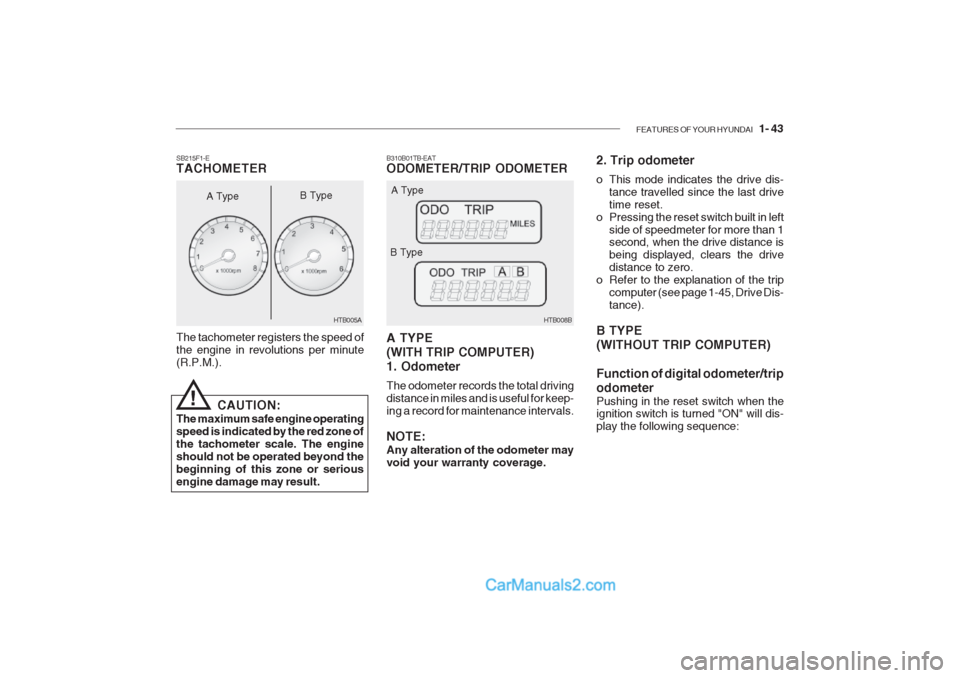
FEATURES OF YOUR HYUNDAI 1- 43
B310B01TB-EAT ODOMETER/TRIP ODOMETER A TYPE (WITH TRIP COMPUTER)1. Odometer The odometer records the total driving distance in miles and is useful for keep-ing a record for maintenance intervals. NOTE: Any alteration of the odometer may void your warranty coverage. HTB008B
A Type
B Type 2. Trip odometer
o This mode indicates the drive dis-
tance travelled since the last drive time reset.
o Pressing the reset switch built in left
side of speedmeter for more than 1 second, when the drive distance is being displayed, clears the drivedistance to zero.
o Refer to the explanation of the trip computer (see page 1-45, Drive Dis-tance).
B TYPE (WITHOUT TRIP COMPUTER) Function of digital odometer/trip odometer
Pushing in the reset switch when the ignition switch is turned "ON" will dis- play the following sequence:
The tachometer registers the speed ofthe engine in revolutions per minute(R.P.M.).
SB215F1-E TACHOMETER
A Type
!
CAUTION:
The maximum safe engine operating speed is indicated by the red zone ofthe tachometer scale. The engineshould not be operated beyond thebeginning of this zone or seriousengine damage may result. HTB005A
B Type
Page 294 of 428
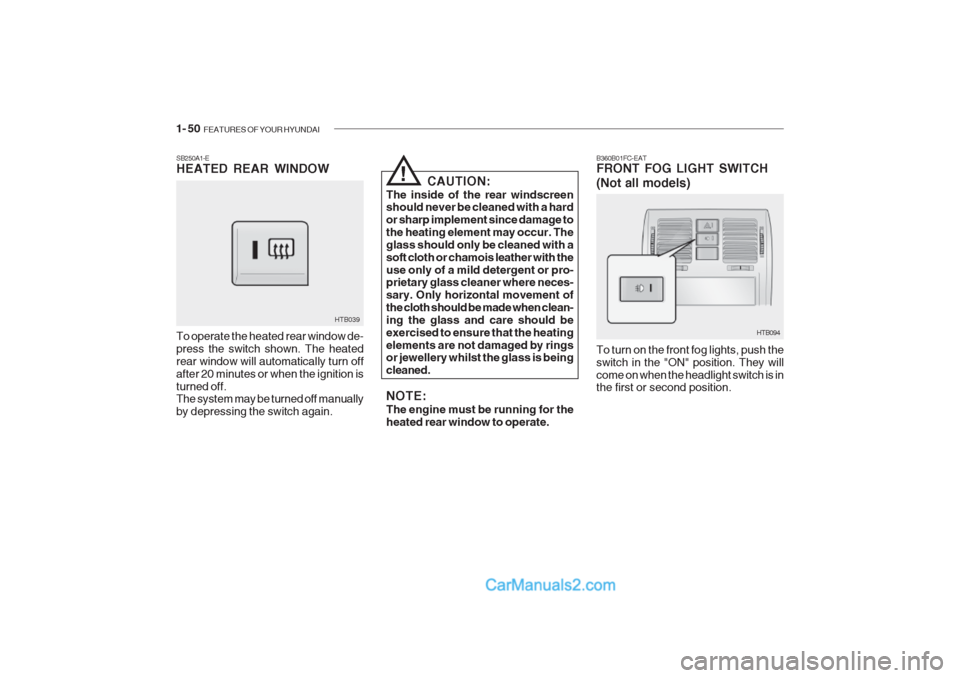
1- 50 FEATURES OF YOUR HYUNDAI
SB250A1-E HEATED REAR WINDOW To operate the heated rear window de- press the switch shown. The heatedrear window will automatically turn offafter 20 minutes or when the ignition isturned off. The system may be turned off manually by depressing the switch again. HTB039CAUTION:
The inside of the rear windscreen should never be cleaned with a hard or sharp implement since damage tothe heating element may occur. Theglass should only be cleaned with asoft cloth or chamois leather with theuse only of a mild detergent or pro- prietary glass cleaner where neces- sary. Only horizontal movement ofthe cloth should be made when clean-ing the glass and care should beexercised to ensure that the heatingelements are not damaged by rings or jewellery whilst the glass is being cleaned. NOTE: The engine must be running for the heated rear window to operate.
! B360B01FC-EAT FRONT FOG LIGHT SWITCH (Not all models)
HTB094
To turn on the front fog lights, push the switch in the "ON" position. They willcome on when the headlight switch is in the first or second position.
Page 305 of 428

FEATURES OF YOUR HYUNDAI 1- 61
SB440A1-E REMOTE FUEL FILLER LID RELEASE (Not all models) The fuel filler lid may be opened from inside the vehicle by pulling up on thefuel filler lid release.
!
HTB115-D
Before closing the bonnet, return the support rod to its clip to prevent it fromrattling. Lower the bonnet until it isabout 30 cm (1 ft.) above the closedposition and let it drop. Make sure that it locks into place.
HTB288
3. Pull the support rod from the bonnet.
HTB308
CAUTION:
Make sure that the support rod has been released prior to closing thebonnet.
4. Hold the bonnet open with the sup- port rod. WARNING:
o Always double check to be sure that the bonnet is firmly latchedbefore driving away. If it is notlatched, the bonnet could fly open while the vehicle is being driven, causing a total loss of visibility,which might result in an accident.
o The support rod must be inserted
completely into the hole providedin the bonnet whenever you in- spect the engine compartment. This will prevent the bonnet fromfalling and possibly injuring you. o Do not move the vehicle with the
bonnet in the raised position, asvision is obstructed and the bon-net could fall or be damaged.
!
Page 306 of 428
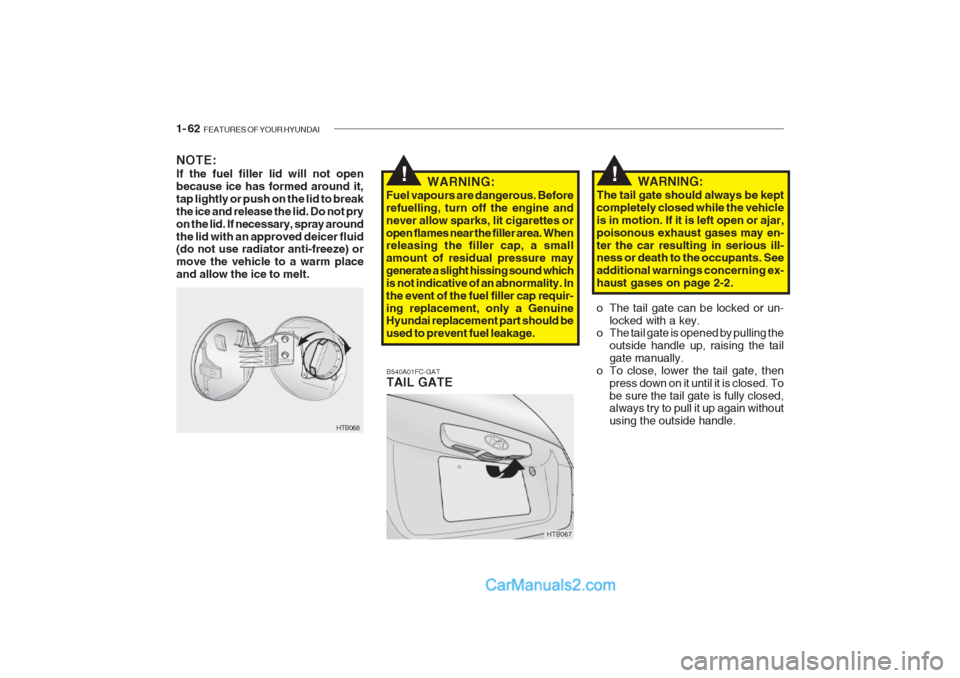
1- 62 FEATURES OF YOUR HYUNDAI
NOTE: If the fuel filler lid will not open because ice has formed around it,tap lightly or push on the lid to breakthe ice and release the lid. Do not pryon the lid. If necessary, spray aroundthe lid with an approved deicer fluid (do not use radiator anti-freeze) or move the vehicle to a warm placeand allow the ice to melt.
B540A01FC-GAT TAIL GATE
HTB067WARNING:
The tail gate should always be kept completely closed while the vehicleis in motion. If it is left open or ajar,poisonous exhaust gases may en-ter the car resulting in serious ill- ness or death to the occupants. See additional warnings concerning ex-haust gases on page 2-2.
o The tail gate can be locked or un- locked with a key.
o The tail gate is opened by pulling the
outside handle up, raising the tail gate manually.
o To close, lower the tail gate, then press down on it until it is closed. Tobe sure the tail gate is fully closed, always try to pull it up again without using the outside handle.
HTB068
!!WARNING:
Fuel vapours are dangerous. Before refuelling, turn off the engine andnever allow sparks, lit cigarettes oropen flames near the filler area. When releasing the filler cap, a small amount of residual pressure maygenerate a slight hissing sound which
is not indicative of an abnormality. Inthe event of the fuel filler cap requir-ing replacement, only a Genuine Hyundai replacement part should be used to prevent fuel leakage.
Page 310 of 428

1- 66 FEATURES OF YOUR HYUNDAI
B560B01O-EAT AUTO FUEL CUT SWITCH (Petrol Engine)
The auto fuel cut switch is located on the driver's side of the engine compartment.In the event of a collision or sudden impact, the auto fuel cut device cuts off the fuel supply. If this device is acti-vated, it must be reset by pressing inon the top of the switch before theengine can be restarted. HTB304
!WARNING:
Before resetting the auto fuel cut switch, the fuel line should be checked for fuel leaks.
HTB098-D
B580A01TB-GAT SUN VISOR
HTB148-D
A Type
B Type
o To use the luggage board with
unfolding, fix it in the luggage board supporter. There will be an audible "Click" when the luggageboard fixes in the supporter.
o The luggage board can be thrown out in the event of a sudden stopor an accident. Unfold the lug- gage board stablely to prevent cargo damage.
HTB302
Page 320 of 428

1- 76 FEATURES OF YOUR HYUNDAI
!
B760A01Y
The pollen filter is located in front of the evaporator unit behind the glove box. It operates to decrease pollutants fromentering the car and to filter the air. To replace the air filter, refer to the page 6-20.
B760A01TB-EAT
POLLEN FILTER (In Front of evaporator unit) (Not all models)
B740D01A-AAT Operation Tips
o If the interior of the car is hot when
you first get in, open the windows for a few minutes to expel the hot air.
o When you are using the air condi-
tioning system, keep all windowsclosed to keep hot air out.
o When moving slowly, as in heavy
traffic, shift to a lower gear. Thisincreases engine speed, which in turn increases the speed of the air conditioning compressor.
o On steep grades, turn the air condi- tioning off to avoid the possibility ofthe engine over-heating.
o During winter months or in periods when the air conditioning is not usedregularly, run the air conditioningonce every month for a few min- utes. This will help circulate the lubricants and keep your system inpeak operating condition. Inside of a vehicle
Evaporator core
Filter
BlowerOutside air
Inside air CAUTION:
o Replace the filter every 12,000 miles (20,000 km) or once a year. If the car is being driven in severe conditions such as dusty, roughroads, more frequent air filter in- spections and changes are re- quired.
o When the air flow rate is suddenly decreased, it must be checked atan authorized dealer.
Page 321 of 428
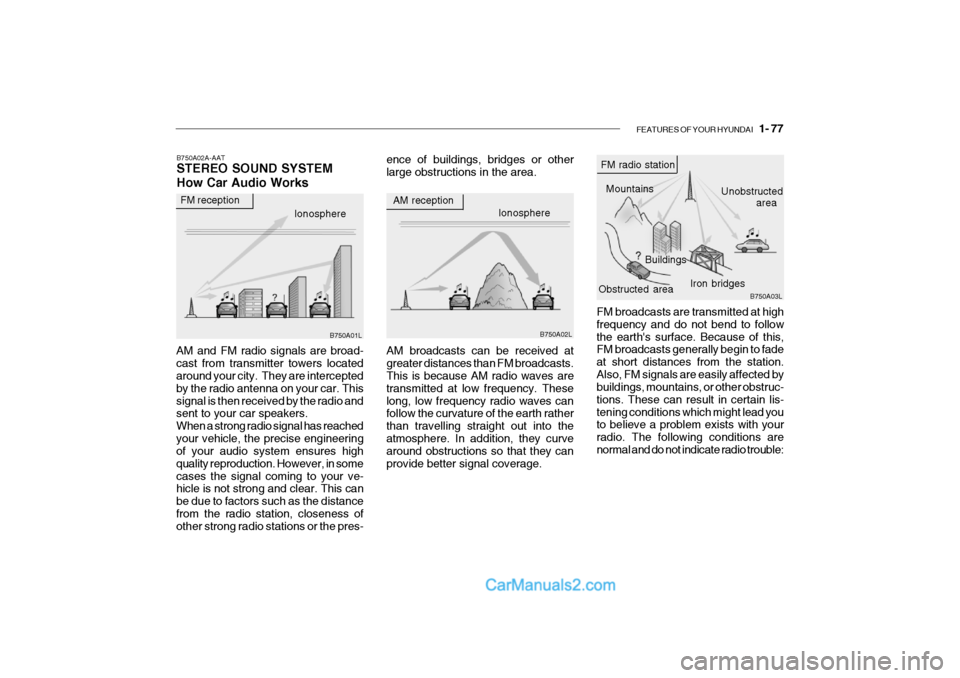
FEATURES OF YOUR HYUNDAI 1- 77
Ionosphere
B750A02L
AM reception
Mountains
Buildings Unobstructed
area
FM radio station
B750A03L
Ionosphere
FM reception
B750A01L Obstructed area
Iron bridges
FM broadcasts are transmitted at high frequency and do not bend to followthe earth's surface. Because of this, FM broadcasts generally begin to fade at short distances from the station.Also, FM signals are easily affected by buildings, mountains, or other obstruc- tions. These can result in certain lis-tening conditions which might lead you to believe a problem exists with your radio. The following conditions arenormal and do not indicate radio trouble:
AM broadcasts can be received atgreater distances than FM broadcasts. This is because AM radio waves are transmitted at low frequency. Theselong, low frequency radio waves can follow the curvature of the earth rather than travelling straight out into theatmosphere. In addition, they curve around obstructions so that they can provide better signal coverage.
B750A02A-AAT STEREO SOUND SYSTEM How Car Audio Works
AM and FM radio signals are broad- cast from transmitter towers located around your city. They are intercepted by the radio antenna on your car. Thissignal is then received by the radio and sent to your car speakers. When a strong radio signal has reachedyour vehicle, the precise engineering of your audio system ensures high quality reproduction. However, in somecases the signal coming to your ve- hicle is not strong and clear. This can be due to factors such as the distancefrom the radio station, closeness of other strong radio stations or the pres- ence of buildings, bridges or otherlarge obstructions in the area.
Page 327 of 428
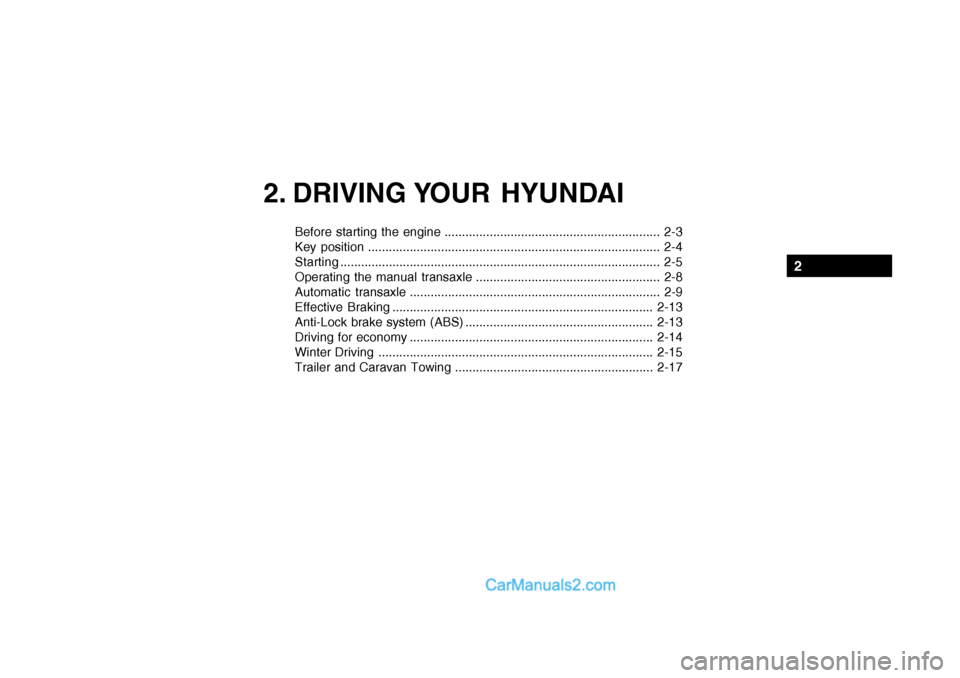
2. DRIVING YOUR HYUNDAI
Before starting the engine .............................................................. 2-3
Key position .................................................................................... 2-4Starting............................................................................................ 2-5
Operating the manual transaxle ..................................................... 2-8
Automatic transaxle ........................................................................ 2-9
Effective Braking ........................................................................... 2-13
Anti-Lock brake system (ABS) ...................................................... 2-13
Driving for economy ...................................................................... 2-14
Winter Driving ............................................................................... 2-15
Trailer and Caravan Towing ......................................................... 2-17
2
Page 328 of 428
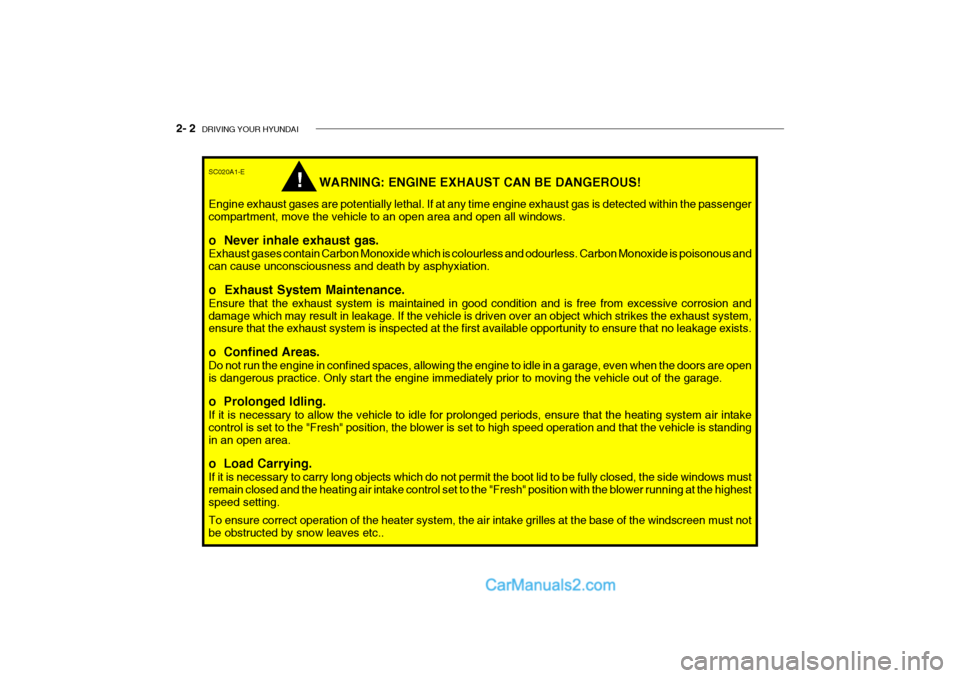
2- 2 DRIVING YOUR HYUNDAI
!
SC020A1-E
WARNING: ENGINE EXHAUST CAN BE DANGEROUS!
Engine exhaust gases are potentially lethal. If at any time engine exhaust gas is detected within the passenger compartment, move the vehicle to an open area and open all windows. o Never inhale exhaust gas. Exhaust gases contain Carbon Monoxide which is colourless and odourless. Carbon Monoxide is poisonous and can cause unconsciousness and death by asphyxiation. o Exhaust System Maintenance. Ensure that the exhaust system is maintained in good condition and is free from excessive corrosion and damage which may result in leakage. If the vehicle is driven over an object which strikes the exhaust system, ensure that the exhaust system is inspected at the first available opportunity to ensure that no leakage exists. o Confined Areas. Do not run the engine in confined spaces, allowing the engine to idle in a garage, even when the doors are open is dangerous practice. Only start the engine immediately prior to moving the vehicle out of the garage. o Prolonged Idling. If it is necessary to allow the vehicle to idle for prolonged periods, ensure that the heating system air intake control is set to the "Fresh" position, the blower is set to high speed operation and that the vehicle is standingin an open area. o Load Carrying. If it is necessary to carry long objects which do not permit the boot lid to be fully closed, the side windows must remain closed and the heating air intake control set to the "Fresh" position with the blower running at the highest speed setting. To ensure correct operation of the heater system, the air intake grilles at the base of the windscreen must not be obstructed by snow leaves etc..